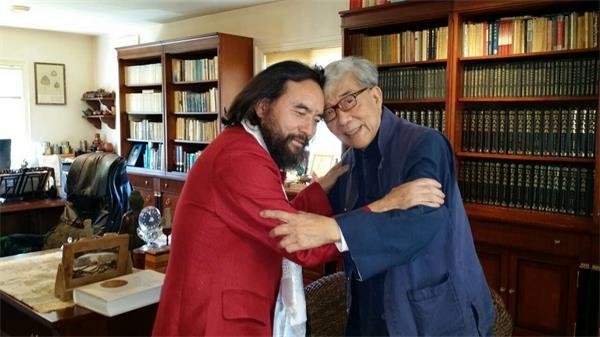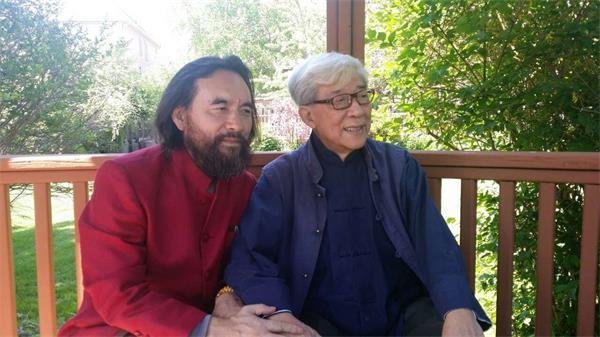
Remembering
Master Tam Shek-wing: A Message of Wisdom
Editor’s Note: Master Tam Shek-wing, founder of the Sino-Tibetan Buddhist
Studies Association in North America (STBSA), is a renowned Buddhist scholar
and Dzogchen master. His insightful writings, moral integrity, and unparalleled
contributions to the spread of Buddhism make him a truly remarkable figure of
our times. His encounter with Master Xue Mo in North America ignited the shared
passion and deep camaraderie between these two distinguished spiritual leaders.
Below is the English translation of a reflective essay by Master Tam,
originally published in May 2015. The original Chinese text is included for
reference.
Joyfully Meeting Master Xue Mo
By Master Tam Shek-wing (Dorje Jigdral,
1935–2024)
Acclaimed
author Xue Mo began his North American journey with a visit to meet me in
Toronto.
Xue
Mo is widely known for his novels, which have garnered great popularity and a
devoted readership. However, his true accomplishments lie in his mastery of
Tibetan Buddhism. As a lineage holder of the Shangpa Kagyu tradition, he is
perhaps the sole Shangpa Kagyu master actively teaching in mainland China
today.
The
Kagyu lineage is divided into two branches: the Dagpo Kagyu, which encompasses
many sub-lineages such as the Karma Kagyu, led by the Karmapa, and the Shangpa
Kagyu, a single, unbroken lineage that flourished during the Yuan and Ming
dynasties. During the Hongwu era, the great Nyingma master Thang Tong Gyalpo
took refuge under Lama Khedrub Dorje Shönu, a Shangpa Kagyu master, and studied
the Shangpa teachings. As a result, the Nyingma tradition integrated elements
of the Shangpa teachings, including the “Five Tantric Deity Sadhana” and the
“Six Yogas of Niguma.” One of Thang Tong Gyalpo’s disciples transmitted these
teachings to Riwoche, where the Shangpa influence remains evident in the
meditation practices of the local Nyingma community.
After
spending 20 years in retreat, Xue Mo moved from Liangzhou to Zhangmutou in
Dongguan, where he has continued his practice and writing in solitude. During
this time, he read some of my works, which inspired his desire to meet me.
Through the kind introduction of Professor Shen Weirong, our meeting was
arranged. Given the historical ties between the Nyingma and Shangpa Kagyu
lineages, I was delighted to welcome him. Upon meeting Xue Mo, I immediately
recognized the disciplined demeanor of a dedicated yogi—a clear reflection of
his spiritual accomplishment. His presence reminded me of my own lapses in
recent years, as I have devoted less time to formal meditation.
Accompanying
Xue Mo was one of his disciples, Huang Wentao, who shared details of his
teacher’s simple lifestyle. Xue Mo lives alone on the seventh floor of an old
building in Zhangmutou, only returning to his wife and son’s home for lunch
before resuming his solitary practice. Sometimes, his dinner consists only of
fruit or a handful of rice crackers. For this trip to North America, he even
brought along a bag of rice crackers, exemplifying his ascetic way of living.
It is not due to financial constraints—he is a respected author, a member of
the Chinese Writers’ Association, and Vice Chairman of the Gansu Writers’
Association. Rather, his minimalist lifestyle reflects the spirit of the
Shangpa Kagyu tradition, which emphasizes austerity. This is likely rooted in
the lineage’s cultural base in Gansu, a region that contrasts sharply with the
material affluence of cities like Beijing, Shanghai, or Guangzhou.
For
dinner that evening, I reserved a table at the Best Fortune Restaurant, one of
the few in Toronto that still serves authentic soups made with fish bones or
oxtail stock. Since Xue Mo comes from Liangzhou, I ordered fresh Alaskan crab
and geoduck to offer him a taste of coastal cuisine. Initially worried that he
might abstain from seafood, I was relieved when he graciously accepted.
Otherwise, I had planned to order Mongolian roasted lamb instead.
Our
conversation was both lively and enriching. When discussing meditative
practices, just a few brief exchanges were enough to establish mutual
understanding. Our shared meditation foundation lies in the Tathagatagarbha, or
“Buddha-Within,” focusing on the clear light, and both of us have actualized
Buddha-nature. With this shared basis, even a glance or handshake conveyed an
immediate heart-to-heart connection.
Xue
Mo stayed for only half a day before continuing his North American tour. I
expressed my hope that he would establish a center here to spread the Dharma
and encouraged him to translate his major tantric works, such as the Luminous
Mahamudra series, into English. With a growing number of Western disciples
under my guidance, I see few books that adequately address their needs. The
Luminous Mahamudra series would be a valuable resource for them, and I am
confident that its English translation would attract many sincere
practitioners. Xue Mo wholeheartedly agreed, and we discussed potential
collaborations with a publisher I know well.
The
Shangpa teachings, which have been shrouded in secrecy for centuries, deserve
to be revealed to the world. As prophesied by Guru Rinpoche, certain teachings
once deemed esoteric should now be made accessible. Xue Mo shares this view,
recognizing the responsibility of our generation to bring these hidden
treasures to light.
Meeting
such a genuine and accomplished master as Xue Mo in my later years indicates a
profound karmic bond with him. Still relatively young, he has a long road ahead
in transmitting the Dharma. I wish him every success in guiding spiritual
seekers worldwide on the path to enlightenment.
追念谈锡永大师: 智慧的寄语
编者说:谈锡永大师是北美汉藏佛学研究会(STBSA)的创始人,著名佛教学者及大圆满法师。他充满智慧的著作、高尚无私的品德,以及对佛法传播的卓越贡献,使其成为我们这个时代真正的杰出人物。他与雪漠上师在北美的会面,点燃了两位卓越精神领袖间共同的热情与深厚的情谊。以下为谈锡永大师于2015年5月发表的一篇中文随笔的英文翻译,文末附有原文供参考。

喜与雪漠上师见面
文\无畏金刚上师谈锡永大师
名作家雪漠来北美一行,首站即来图麟都(Toronto)与笔者见面。
雪漠出版过几本小说,甚为畅销,拥戴者甚多,其实他的成就却在藏密修为。他是香巴噶举派的传人,如今在汉地可以说是唯一一位香巴噶举的上师。
噶举派有两大支,一支为塔巴噶举,其中再分成许多派,以噶玛噶举为首,大宝法王即属于此派。另一支则是香巴噶举,没有分派,一脉单传,在元明时甚为鼎盛。于洪武年间,宁玛派上师荒原王(Thang
sTong rGyal Po)即曾皈依该派金刚童上师(Bla Ma rDo rJe gZhon Nu)学习香巴教法,所以宁玛派的教法中,便融和有香巴派「五金教法」及「奶格六法」。荒原王有一位弟子往类乌齐(Riwoche)传法,因此类乌齐的宁玛派观修,尤多香巴派教法的影子。
雪漠上师闭关二十年后,由凉州移居东莞樟木头镇,闭门著作修法,期间读过笔者几本书,因此很想跟笔者见面,后来找到沈卫荣教授作沟通,于是跟笔者定下见面的日期,笔者既知宁玛派与香巴噶举有渊源,对雪漠上师甚为欢迎。甚至见面,但见雪漠上师是一个典型的瑜伽士面貌,立即生出好感。人的面貌与神气,完全与其修为有关,足见雪漠是一位勤修瑜伽的行者,笔者近十年已少作观修,见之未免形愧。
倍同雪漠来访的,有一位他的弟子,名黄文韬,他对笔者说,雪漠上师生活得非常朴素,独自一人住在樟木头一家旧楼的第七层,只每天中午回妻儿住处中饭,再回楼后即不外出,有时晚上只吃些水果或米饼,便当是晚餐。这次来北美,上师居然带同一包糙米饼,由此即可见其生活风格。他不是没钱,他是名作家,又是中国作家协会会员,甘肃省作家协会副主席,有不错的工资,他的朴素,实在是香巴噶举的风格,香巴派甚至主张苦行,这大概跟传法区域有关。如今汉地的传法中心在甘肃凉州,与北京上海广州相比,自然朴素得多。
那天晚饭,笔者订在百福酒楼。说句题外话,如今图麟都的酒家,大概只有百福与鱼乐轩两家有真正的上汤,所以笔者外膳必选此二家,余外便不敢希望太大,只祈求一滴香火腿精等东西不要下得太多,如果有真正的鱼汤、鱼骨汤、牛骨汤,那便已经可以称为美食。
因为雪漠上师是凉州人,所以笔者在百福特别定下鲜阿拉斯加蟹与鲜象拔蚌,让这西北人一尝海产风味,现在一听雪漠上师生活朴素,不禁心中一跳,耽心他不吃海产,然而雪漠却很随和,他点点头说,也可以吃,如若不然,笔者便要另订蒙古烤肉。
此次我们二人相见,可谓交谈甚欢,关于两派的观修,只须一言半语便彼此心照,因为我们的观修根基都在如来藏,主修的都是光明,现证的都是如来藏果,既然基、道、果都相同,所以一个眼神一个手势,便彼此心心相照。
雪漠只逗留大半日便辞别笔者,继续他的北美行程,笔者很希望他在北美能成立一个传法的据点,同时希望他的密乘著作(例如已出版的四大卷《光明大手印》),能有英文译本,现在笔者有教授一些洋人弟子,可以介绍给他们看的书并不多,《光明大手印》便很适合他们阅读,所以相信雪漠著作的英译本,一定能吸引许多虔诚观修佛法的洋人。笔者将此意告知雪漠,他亦甚为首肯。他问到出版问题,笔者跟一家英文出版社有相当关系,相信可以帮助他印行英译本,为此雪漠相当高兴,笔者也高兴,因为藏秘千年的香巴教法,能有公开秘密的一天,笔者认为,我们这一代有责任传法的人,实在应该公开一些祖先的秘密,古代认为应该守秘的教法,根据莲师授记,现在应该公开。雪漠上师对此亦颇为赞同。
笔者晚年,能跟雪漠这样知见、观修都正派的上师见面,可以说是有甚深缘份,他还年纪不大,传法的路还很长,祝他一路顺利,能引导学人走上解脱道。